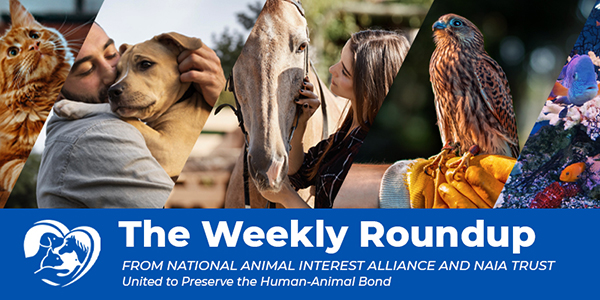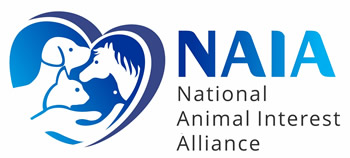
Inside This Issue:
- Stray and Wild Dog Populations a Growing Problem in the United States
- It’s Time to Add Humpback Whales to Our List of Tool-Using Animals
- Study: Fostering Dogs and Cats Is Good for You
- Wildlife Crossing... Without the Collisions
- Rescue Owners Going to Jail After Pleading Guilty to Animal Abuse
Stray and Wild Dog Populations a Growing Problem in the United States

The stray life is hard for dogs and cats. It is also a nuisance and danger to communities.
How does an animal control staff of seven handle up to 60 urgent calls per day and numerous out of control packs of stray and wild dogs? The quick and dirty answer is that, well… it doesn’t. And that’s just life for Animal Services in Bibb County, Georgia. This isn’t an indictment of the animal control staff – there simply aren’t nearly enough employees, cages, or hours in the day for them to perform their job the way they would like to. It’s a dire situation, and one that will only get worse as the number of roaming animals further outpaces the capabilities of animal services.
This problem isn't unique to Macon, Georgia. For example, New York City has been overrun by stray and feral cats, while Texas’s Del Mar College put out traps for strays earlier this year after dog packs attacked multiple people. One of the dog pack victims in Texas had to undergo a series of rabies shots after being bitten. Yikes! Stray and feral animals are a serious public health and safety issue for obvious reasons. Less obviously, out of control strays represent a failure on our part to adequately fund and enforce reasonable animal control policies. The unfortunate truth is that problems like this are complicated, wrought with emotion and conflicting philosophies, and require more labor and resources to solve than many people are willing to give. Sadly, it may take multiple tragedies before action is finally taken.
It's Time to Add Humpback Whales to Our List of Tool-Using Animals

You may not like it, but this is what peak performance looks like.
While your uncle’s collection of wrenches and screwdrivers is no doubt impressive, humans are far from the only animals to use tools. Other primates use tools. Elephants, crows, marine mammals, cephalopods, fish, and insects have been observed using tools, too. And today, we can add the great humpback whale to the list of animals that we know use tools. In this case, the whales actively create their own tools and engage in cooperative actions – in dramatic fashion!
Humpback whales create massive bubble nets to increase their yield when fishing – up to seven times more than just regular feeding. A group of whales work together to create a bubble net. This involves several whales diving under a school of fish or krill. One or more whales will swim in a spiral pattern under the prey, releasing bubbles from their blowholes as they go. This creates the vertical “net” of bubbles – a tool – that rises toward the surface. The bubbles act as a barrier, concentrating the prey into a column. Trying to avoid the bubbles confuses the fish, so they tighten into a dense ball near the center. Unfortunately for the fish, this is a terrible tactical move, as this form of “defense” allows the whales to swallow large amounts of prey in a single gulp as they swim up through the center of the bubble net. While we are firmly on Team Whale for this story, it’s hard not to feel a little sorry for the utterly hapless fish. They really had no chance.
This is a very energy-efficient hunting method that showcases a high level of social cooperation and communication among whales – each whale playing a specific role in the creation and utilization of the bubble net. Bubble net feeding is commonly observed in humpback whales in colder, nutrient-rich waters, and usually occurs during the summer feeding season when these whales are gorging on food to build up energy reserves for migration. This is one of the most sophisticated hunting techniques seen in marine mammals, highlighting their social complexity and understanding of their environment.
Study: Fostering Dogs and Cats Is Good for You

Some fosterers were bummed when they had to give up their animals, but it was still an overwhelmingly positive experience.
New research on the effects of fostering rescue animals validates something we all probably felt was true: it’s not only good for animals, it provides benefits to people, as well. In a study of 131 foster caregivers, participants enjoyed remarkable feelings of affection and companionship from their rescue dog or cat. People who fostered dogs also reported improvements in their emotional, physical, and social wellbeing. Participants did not, however, experience a boost to their mental wellbeing – a reminder that we need to be careful when discussing a relationship between mental health and caring for animals.
Finally, some participants expressed feelings of grief with giving up the foster animal, but not to the point of souring the entire experience, and the vast majority of participants said they were likely to foster again in the future. That's pretty rosy!
Again, much of this is common sense that won’t challenge anyone’s world view, but the data is still important. Our understanding of the human-animal bond is far from complete, and reports from participants in the field are always helpful. Further, sometimes the things that “feel” right to most people turn out to be off base (see: numerous trends in dog training and husbandry), so it’s great having some numbers to back our assumptions!
Wildlife Crossing... Without the Collisions

A wildlife crossing or ecoduct in the Netherlands. Talk about function meeting form!
Wildlife corridors continually prove their value with each one built and studied. They allow animals to travel without becoming roadkill or causing serious accidents, which is vital, because while injuries or damage to your vehicle can make for a rough day, some species are literally being pushed to the brink by automobile collisions!
Conceptually designed in the 1950s to allow deer to cross landscapes for hunters – another example of hunters being on the leading edge of conservation – wildlife corridors have begun to spread among urban centers to connect greenspaces for animals. The effectiveness of a corridor often depends on its ability to cater to the specific needs of the target species, considering factors like home range, behavior, and dispersal capabilities.
While there are specific targets, wildlife corridors can be effective in enhancing biodiversity and promoting genetic diversity, and reducing human-wildlife conflict. However, their success depends on careful design, adaptive management, and continuous monitoring. When well-implemented, wildlife corridors can be powerful tools for ensuring the long-term survival of species in increasingly fragmented landscapes.
Rescue Owners Going to Jail After Pleading Guilty to Animal Abuse

Officers discovered "unsanitary conditions" and crates upon crates full of dogs and cats when entering the rescue. Two dead dogs were also removed from the premises.
In New Jersey, two self-described “crazy rescue ladies” are going to jail and will never be permitted to own or work with animals again after pleading guilty to animal cruelty. This heavy punishment stems from 2022, when approximately 130 dogs and 40 cats were removed from the women’s home – and conditions of extreme crowding and filth – by hazmat-clad rescuers. Before the animals were seized, the outfit was a 501(c)(3) with a social media presence, calling itself a “responsible rescue” focused on saving street animals and educating the public on animal overpopulation.
Interestingly, the complaint that led to the seizure of the rescue’s animals was an anonymous tip that someone was running a puppy mill out of their home. This assumption suggests that even after numerous, well-publicized “rescued from the rescue” stories over the last few years, people may be reluctant to assume that the “good guys” might be harming animals. This also goes to show how important it is that everybody who works with animals, including rescues and other charities, needs to be subject to reasonable regulations and inspections. It doesn’t matter how good and pure someone’s intentions are: when it comes to animal care and conditions, problems can spiral out of control in just a matter of days.
Also in the News...
★ Congressman Kennedy Introduces Bill to Permanently Pause New CDC Rule on Dogs Crossing Border from Canada (Animal Legislation; CDC Rule)
★ What’s stupider than rehoming rabid pit bull puppies? Denying the risk. ("Humane" Relocation; Rescue Trafficking; Public Health & Safety)
★ He once poached the wild animals of Zimbabwe. Now he preaches against it (Poaching & Wildlife Trafficking; Education & Opportunities)
★ Appalachian Fair delights with cute animals from regional farms (Fairs & Farm Life)
★ Woman arrested for allegedly killing cat, eating it in front of neighbors (Tales of the Bizarre and Horrific)
★ Clear The Shelters: Loudoun County animal shelter waiving adoption fees for all its animals (Rescues & Shelters; Events & Opportunities)
★ Which animals can and can’t fart? (The Great Scientific Mystery Finally Solved)
★ 75-year-old feeding animals is attacked, dragged and killed by bull, Texas officials say (Animal Attacks; Be Careful Out There, Folks)
★ What was the first animal on Earth? (Comb Jellies; Precambrian Critters)
★ 6 animals Nat Geo staff think are very demure, very mindful (Subjective & Silly Lists)
Click here to see what is happening legislatively

